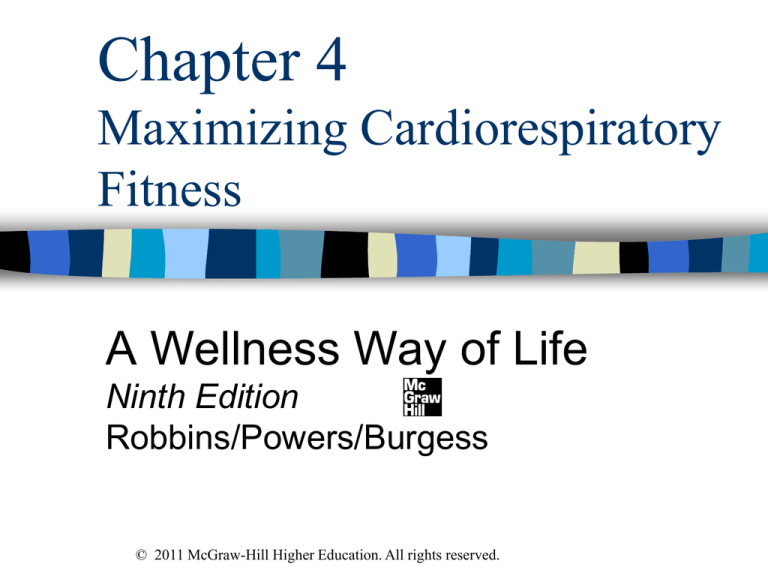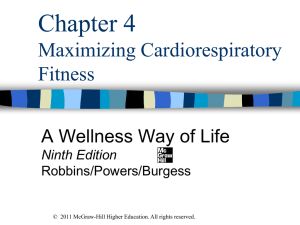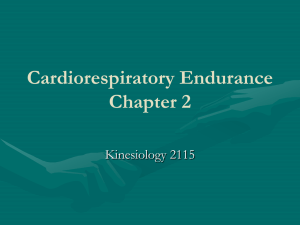
Chapter 4
Maximizing Cardiorespiratory
Fitness
A Wellness Way of Life
Ninth Edition
Robbins/Powers/Burgess
© 2011 McGraw-Hill Higher Education. All rights reserved.
What stage of change are you in/
(p. 98)
• Do you do aerobic exercise at least
three to five times per week?
Study Question 1
Why is exercise called
“medicine”?
© 2011 McGraw-Hill Higher Education. All rights reserved.
Importance of Exercise as
Medicine
• An epidemic of hypokinetic disease is prevalent in
our society today.
• Hypokinetic disease, such as obesity, coronary heart
diseases, cancer, osteoporosis, and diabetes are
related to inactive lifestyles.
• Approximately 250,000 premature deaths occur due
to lack of exercise.
• Nearly 73% of all Americans are considered
overweight and a third are obese.
• Our nation’s children are getting fatter.
• College students are showing early forms of
hypokinetic diseases.
© 2011 McGraw-Hill Higher Education. All rights reserved.
Copyright © The McGraw-Hill Companies, Inc. Permission required for reproduction or display.
Effects of fitness on mortality
Figure 3-2
© 2011 McGraw-Hill Higher Education. All rights reserved.
Study Question 2
What are the benefits of
cardiorespiratory fitness?
© 2011 McGraw-Hill Higher Education. All rights reserved.
Benefits of Aerobic Exercise
Cardiorespiratory
•
•
•
•
•
•
•
•
Lower resting heart rate
Increased stroke volume
Increased VO2Max
Increased performance
Lower blood pressure
Lower blood lipids
Quicker recovery
Fewer illnesses
© 2011 McGraw-Hill Higher Education. All rights reserved.
Benefits of Aerobic Exercise
Body Composition
• Lower body fat
• More muscle mass
Benefits of Aerobic Exercise
Psychological
•
•
•
•
•
•
•
•
•
•
Increased self-discipline
Enhanced well-being
Lower stress levels
Increased confidence
Reduced depression
Better sleep
Improved memory and mental acuity
Feeling of relaxation
Improved mood
Reduced cognitive decline and dementia
Study Question 3
How are the FITT prescription
factors for developing physical
fitness defined and applied?
© 2011 McGraw-Hill Higher Education. All rights reserved.
FITT
• Frequency – 3 to 5 times per week (up
to 7 times per week is acceptable)
• Intensity – 60-80% of heart rate
reserve. Use the Karvonen equation.
• Time – 20 to 60 minutes depending on
intensity.
• Type – aerobic vs. anaerobic. Aerobic
is continuous and rhythmic. Choose
activities you enjoy and are
reasonable.
© 2011 McGraw-Hill Higher Education. All rights reserved.
Study Question 4
How is training heart rate
calculated using the Karvonen
formula?
© 2011 McGraw-Hill Higher Education. All rights reserved.
Target Heart Rate
Karvonen Equation
• Target Heart Rate (THR) = MHR-RHR x
intensity + RHR
• Max Heart Rate (MHR) = 220-age
• Resting Heart Rate (RHR) = pulse per minute at
complete rest (after about 30 minutes of rest)
• Intensity = 60-80% depending on desired level
• Example of 20 year old with RHR of 70 at 60%
intensity:
• 220-20=200 (MHR), 200-70=130 (HRR)
130x.6+70=148 THR
© 2011 McGraw-Hill Higher Education. All rights reserved.
Copyright © The McGraw-Hill Companies, Inc. Permission required for reproduction or display.
Estimated target heart rate range.
© 2011 McGraw-Hill Higher Education. All rights reserved.
Study Question 5
How is the Rate of Perceived
Exertion Scale used to measure
workout intensity?
© 2011 McGraw-Hill Higher Education. All rights reserved.
Rate of Perceived Exertion-Borg Scale
• Rate of Perceived Exertion (RPE) is
sensing how hard or easy a workout
feels and rating that on a scale from 1
(very easy effort) to 10 (maximal effort).
• Intensity of exercise can be measured
by RPE.
• To receive cardiorespiratory benefit from
exercise and improve fitness, you
should feel the effort is moderate to hard
or 4 to 6 on the RPE chart. Younger
more fit exercisers may workout up to a
RPE of 7 and beyond.
© 2011 McGraw-Hill Higher Education. All rights reserved.
Study Question 6
How is the progressive overload
principle applied to a
cardiorespiratory exercise
program?
© 2011 McGraw-Hill Higher Education. All rights reserved.
Progressive Overload
• Gradual increase in physical
activity. No overload = no
increase in performance.
Too much overload = injury
© 2011 McGraw-Hill Higher Education. All rights reserved.
Study Question 7
What are specific goals for the
FITT and the Department of
Health and Human Services
(DHHS) exercise guidelines?
© 2011 McGraw-Hill Higher Education. All rights reserved.
FITT
• 20-60 minutes (minimum of 20-30
minutes)
• Moderate to vigorous intensity: 60-80%
HRR (Example: walking 4.0-4.5 mph,
jogging 5 mph, biking 10 mph)
• 3-5 days per week
• FITT’s primary goal is aerobic fitness
© 2011 McGraw-Hill Higher Education. All rights reserved.
Department of Health and
Human Services (DHHS)
Per Week
• At least 2.5 hours (150 minutes) of moderateintensity aerobic activity: 40-60% HRR (Ex.
Brisk walking at 3.5 mph
Or
• 1.5 hours (75 minutes) of vigorous intensity
aerobic activity: jogging, swimming laps
• Activity should be done in at least 10 minute
bouts and can be spread throughout the week
DHHS Guidelines continued
For more health benefits
• 5 hours (300 minutes) of moderateintensity aerobic activity or 2.5 hours
(150 minutes) of vigorous-intensity
aerobic activity
• Muscle strengthening activities
(moderate or high intensity, all musclwe
groups), 2 or more days a week
FITT and DHHS Guidelines for
weight loss or weight loss
maintenance
• 1 hour per day at least 5 times per week
(300 minutes per week at least)
• Moderate aerobic activity
• May require more activity than base
amount needed for health benefits
• Try to accumulate 450 minutes or more
per week to keep weight off
Study Question 8
Which aerobic exercise activity (of the
eight found in this chapter) would you
be most interested in to develop
cardiorespiratory endurance (CRE).
The eight activities include aerobic
dance, bicycling, fitness swimming,
fitness walking, indoor exercise
equipment, in-line skating, jogging,
water exercise/aqua aerobics.
© 2011 McGraw-Hill Higher Education. All rights reserved.
Recommended Lifetime Exercise
Activities
•
•
•
•
•
•
•
•
•
Aerobic dance and/or Step aerobics
Indoor cycling classes
Bicycling
Fitness swimming
Fitness walking
Indoor exercise equipment
In-line skating
Jogging
Water exercise
© 2011 McGraw-Hill Higher Education. All rights reserved.
Study Question 9
How would you describe the
10,000 steps per day wellness
goal? How would you initiate it?
© 2011 McGraw-Hill Higher Education. All rights reserved.
10,000 Steps: A Daily Life Goal
• Goal is to increase activity levels by encouraging
people to move at least 10,000 steps per day – the
equivalent of about 5 miles.
• Sedentary people typically take less than 5,000 steps
per day.
• A basic pedometer can measure the steps (with
walking or most other vertical types of physical
activity).
• Follow the steps on Table 4-3 for guidelines to reach
10,000 steps.
© 2011 McGraw-Hill Higher Education. All rights reserved.









